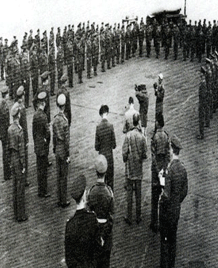 Republic of South Africa
Republic of South Africa
List for UN Allies
Background of Participation
Upon the resolution of the UN Security Council calling for military assistance to South Korea, South Africa decided to dispatch one combat squadron. It agreed with the USA that the latter would supply all necessary equipment.The 2nd Squadron of South Africa, nicknamed Flying Cheetah, arrived in Japan on November 5, 1950. The squadron moved to the Johnson base. It took over sixteen F-51(Mustang) of the US Air Force. The squadron was organized as an advanced force, composed of 13 officers, and 21 soldiers. It arrived at Suyong Airport, Pusan, on November 16th. The commander and four pilots flew F-51s to Pusan. The squadron was attached to the US 18th Bomber Corps.
Activity of the Air Force
On November 19th, the Squadron flew, in four-plane formation, to the north of the Chongchon River. It attacked a North Korean assembly area and field supply point. The Squadron moved to Pyongyang airport in order to support UN forcesâ final offensive on November 22nd.
At that time, Pyongyang airfield was heavily destroyed by UN bombardment and North Korean sabotage operation (this was done so that the UN Forces could not benefit from the remaining supplies). Despite this unfavorable condition, the Squadron made sorties of air patrolling and intercepting the enemyâs rear positions from November 23rd.
On November 26th, strong dust wind blew while landing. Because of this, there was an accident in which a Mustang collided with a tractor. Two fighter planes were destroyed in this accident. Nevertheless, the South African Squadron made a sortie to Kunuri in order to provide close air support for UN ground forces as well as to bomb enemy supply transport vehicles.UN forces decided to retreat in early December. The Squadron moved to Suwon Airport. On December 5th, the Squadron made a sortie to bomb covered carriages of explosives left in the enemy area. In the process of bombing, one Mustang crashed. The pilot was rescued. The South African Squadron made 20 sorties on December 20th, destroying 57 buildings, 15 trucks, and a railroad facility.With UN forcesâ resumption of counterattack at the end of January 1951, the Squadronâs number of sorties rapidly increased. For two months from February 12th, it made 1,000 sorties. Especially on March 1st, 36 sorties were made, marking a record among the units under the 18th Bomber Corps.
UN forces launched Operation Strangle. The Squadron joined in this operation from August 19th. It made sorties to bomb enemy railroads in Sunchon and Sariwon. In order to support ground forces effectively, the Squadron moved to the Hoengsong base in the middle of the front on September 22nd.As the UN Air Force planned the Operation Saturate on February 25, 1952, the South African Squadron made sorties to bomb railroads and bridges in north of Chongchon River. The Squadron engaged in an air battle with MiG fighters on March 20th. The formation of 8 Mustangs shot down one MiG fighter with one Mustang being brought down. As the rate of disuse of Mustangs increased rapidly, due to the lack of fittings, the Squadron returned all Mustangs to the Jinhae base to exchange with jets at the end of December.
The South African Squadron moved from Hoengseong to the Osan base in January 2, 1953. It trained in the operation of the F-86. From the middle of March, it was able to carry out actual operations with F-86 fighters.On March 11, for the first time since it had become armed with F-86s, the Squadron advanced to south of the Yalu for air patrolling. On May 1st, the South African Squadron participated in the operation of bombing Pyongyang. The Squadron participated in the UNCâs operation of destroying airports within North Korea in the middle of July. It destroyed 6 old-fashioned planes at Shinuiju airport on July 18th. Although the armistice was approaching, the Squadron made as many as 41 sorties a day in order to observe enemy activity.
Republic of South Africa, which dispatched 826 soldiers to Korea, suffered 34 casualties. The Squadron withdrew from Korea on October 29, 1953, after returning aircraft to the US Air Force on September 7th.
